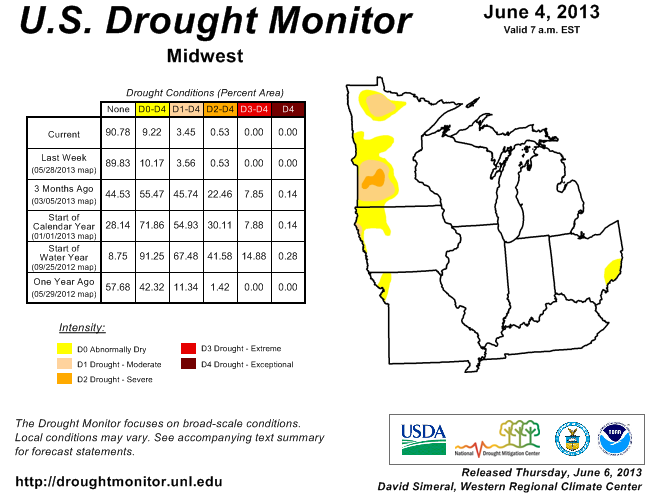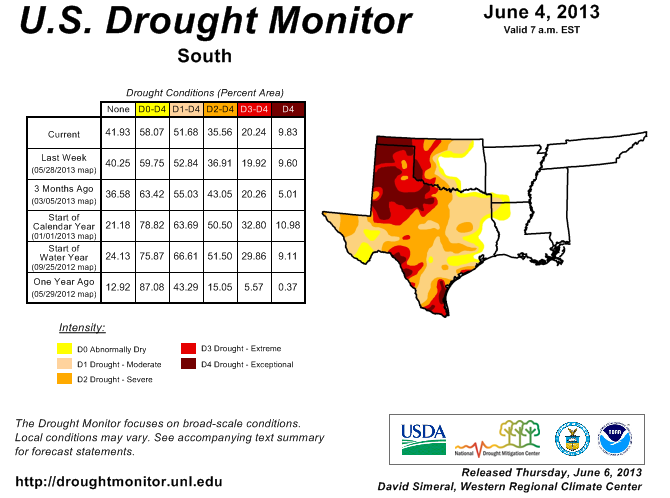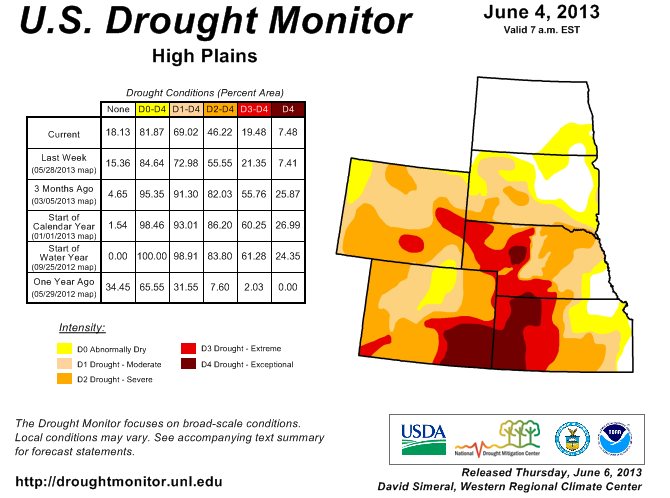Drought Monitor Reflects Slight Nationwide Improvement

According to the National Drought Monitor, 54.98% of the contiguous U.S. is covered by some form of drought, which is a slight improvement from 56.87% last week. The monitor notes that across the Great Plains, scattered shower activity led to some modest improvements in areas of drought over the eastern halves of Kansas Oklahoma, and South Dakota, while western Corn Belt areas saw continued shower activity that led to further improvements in drought areas of western Iowa and southwestern Minnesota. In the South, modest rainfall led to minor improvements over portions of the Texas Panhandle, central and southeast Texas, and northwestern Louisiana.
For the Midwest, the monitor states, "Continued cool and wet conditions across parts of the region have renewed planting delays of soybeans across parts of Illinois, Iowa, Missouri, and Wisconsin according to the USDA National Agricultural Statistics Service (NASS). Minor improvements were made in northwestern Iowa and southwestern Minnesota in areas of Abnormally Dry (D0) and Moderate Drought (D1) as well as Severe Drought (D2) as one-to-two inches of rain fell during the 7-day period. Temperatures throughout the region were below normal during the past week."
In the South, modest rainfall fell over much of the region, with some locally heavier accumulations occurring over portions of eastern and central Texas. "In east Texas, conditions continue to improve and areas of Abnormally Dry (D0) and Moderate Drought (D1) saw one-category improvements in response to rainfall accumulations of one-to-three inches over during the past week. In the Texas Panhandle, some locally heavy rainfall accumulations (2-5 inches) led to one-category improvements in areas of Exceptional Drought (D4) and Extreme Drought (D3). In the Trans-Pecos and west Texas, modest rainfall led to one-category improvements in Brewster and Pecos counties in areas of Moderate Drought (D1)," it states. "In west Texas, one-category improvements were made in areas of Exceptional Drought (D4) and Extreme Drought (D3) as a result of rainfall accumulations of one-to-two inches during the past week. In south-central Texas, continued dry conditions led to the expansion of areas of Exceptional Drought (D4) and Severe Drought (D3). In northwestern Louisiana and southwestern Arkansas, modest rainfall (1.5-3 inches) led to one-category improvements in areas of Abnormally Dry (D0) and Moderate Drought (D1). Temperatures across the region were generally near-normal during the past week."
In the northern Plains, a cool and wet pattern persisted in North Dakota and extreme eastern portions of South Dakota, and Nebraska where one-category improvements were made in areas of Abnormally Dry (D0) and Moderate Drought (D1) receiving more than two inches of rain during the past week. "Across the Dakotas, recent rains have continued to help improve pasture and range conditions. In the southern tier, modest rainfall amounts were observed over eastern and north-central Kansas leading to continued improvements in areas of Abnormally Dry (D0), Moderate Dry (D1), and Severe Dry (D2). According to the USDA NASS Kansas Crop Progress and Conditions Report, wet field conditions continued to cause some planting delays of soybeans and sorghum, especially in low-lying areas. Conversely, western Kansas has not benefited from the recent storms and rangeland conditions remain in poor to very poor condition," it states. "In Oklahoma, some locally heavy rainfall (2-3 inches) led to minor improvements in south-central and north-central regions in areas of Abnormally Dry (D0) and Moderate Drought (D1). Despite some locally heavy rainfall in parts of extreme western Oklahoma during the past week, conditions on the map remained unchanged as rainfall deficits persisted. During the past week, temperatures in the northern tier were below-normal while most of the southern tier was near-normal."
In its outlook for the next five days, the monitor says moderate to heavy precipitation is expected over the Midwest and Northeast while modest rainfall is forecasted across the eastern portions of the Great Plains, Southeast, and Pacific Northwest. The 6-10 day outlooks call for a high probability of above-normal precipitation and below-normal temperatures across New England, the Mid-Atlantic, the Midwest, the northern Great Plains, and the Pacific Northwest. In contrast, a high probability of above-normal temperatures and below-normal precipitation are expected across the Intermountain West, southern Great Plains, and the South.











